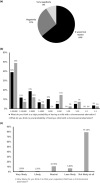Knowledge and attitude of pregnant women in the Kingdom of Saudi Arabia toward Noninvasive prenatal testing: A single center study
- PMID: 35481946
- PMCID: PMC9266591
- DOI: 10.1002/mgg3.1960
Knowledge and attitude of pregnant women in the Kingdom of Saudi Arabia toward Noninvasive prenatal testing: A single center study
Abstract
Background: Noninvasive prenatal testing (NIPT) is a screening tool for chromosomal aneuploidies. Prior knowledge of NIPT is an inherent factor in the decision-making process. We assessed the knowledge and attitude of pregnant women related to prenatal testing with a particular focus on NIPT.
Methods: A prospective cross-sectional study, using a culturally validated questionnaire, was conducted with 342 pregnant women of whom 74.9% consented for prenatal screening. Mean age and gestational weeks ± standard deviation was 31 ± 5 and 26 ± 11, respectively.
Results: A positive/very positive attitude was observed to ultrasound, followed by FCT, NIPT, and lastly to CVS. More than half of the participants (56.1%) had no previous knowledge of NIPT. A reaching significance association was detected between education and knowledge of NIPT. Significant association was detected between risk for aneuploidy and knowledge of NIPT. The majority (74%) indicated their willingness to perform the test. The effect and value of society on the pregnant women to make a decision regarding NIPT was negligible.
Conclusion: The pregnant women in the current study displayed a lack of knowledge and awareness regarding prenatal screening, particularly the NIPT. We recommend that pregnant women receive adequate counseling regarding prenatal screening to increase their awareness and knowledge of prenatal testing, including NIPT.
Keywords: attitudes; decision-making; knowledge; prenatal diagnosis.
© 2022 The Authors. Molecular Genetics & Genomic Medicine published by Wiley Periodicals LLC.
Conflict of interest statement
Authors declare no conflict of interest.
Figures




Similar articles
-
Knowledge and future preference of Chinese women in a major public hospital in Hong Kong after undergoing non-invasive prenatal testing for positive aneuploidy screening: a questionnaire survey.BMC Pregnancy Childbirth. 2015 Sep 2;15:199. doi: 10.1186/s12884-015-0636-7. BMC Pregnancy Childbirth. 2015. PMID: 26330276 Free PMC article.
-
Attitude changes toward prenatal testing among women with twin pregnancies after the introduction of noninvasive prenatal testing: A single-center study in Japan.J Obstet Gynaecol Res. 2021 Nov;47(11):3813-3820. doi: 10.1111/jog.15010. Epub 2021 Sep 6. J Obstet Gynaecol Res. 2021. PMID: 34490692 Free PMC article.
-
Financial contribution as reason to opt out of non-invasive prenatal testing.Eur J Obstet Gynecol Reprod Biol. 2023 Aug;287:130-136. doi: 10.1016/j.ejogrb.2023.06.009. Epub 2023 Jun 9. Eur J Obstet Gynecol Reprod Biol. 2023. PMID: 37311275
-
Perspectives of Pregnant People and Clinicians on Noninvasive Prenatal Testing: A Systematic Review and Qualitative Meta-synthesis.Ont Health Technol Assess Ser. 2019 Feb 19;19(5):1-38. eCollection 2019. Ont Health Technol Assess Ser. 2019. PMID: 30838086 Free PMC article.
-
Patient perspectives on noninvasive prenatal testing among black women in the United States: a scoping review.BMC Pregnancy Childbirth. 2023 Mar 16;23(1):183. doi: 10.1186/s12884-023-05423-w. BMC Pregnancy Childbirth. 2023. PMID: 36927679 Free PMC article.
Cited by
-
A decade later: Assessing pregnant women's perspectives on non-invasive prenatal testing (NIPT) in Saudi Arabia.Heliyon. 2024 Nov 13;10(22):e40379. doi: 10.1016/j.heliyon.2024.e40379. eCollection 2024 Nov 30. Heliyon. 2024. PMID: 39624311 Free PMC article.
-
Exploring measurement tools used to assess knowledge, attitudes, and perceptions of pregnant women toward prenatal screening: A systematic review.Womens Health (Lond). 2024 Jan-Dec;20:17455057241273557. doi: 10.1177/17455057241273557. Womens Health (Lond). 2024. PMID: 39206551 Free PMC article.
-
Understanding the Awareness of Prenatal Genetic Screening Tests Among Pregnant Women in India: A Cross-Sectional Study.Cureus. 2024 Mar 26;16(3):e56932. doi: 10.7759/cureus.56932. eCollection 2024 Mar. Cureus. 2024. PMID: 38665723 Free PMC article.
-
CffDNA screening for Niemann-pick disease, type C1: a case series.Front Med (Lausanne). 2024 Aug 5;11:1390693. doi: 10.3389/fmed.2024.1390693. eCollection 2024. Front Med (Lausanne). 2024. PMID: 39161410 Free PMC article.
References
-
- Akiel, M. A. , Mohamud, M. S. , Aldriwesh, M. G. , Alamri, H. S. , Alhawiti, N. M. , & Alfhili, M. A. (2020). Translation and cross‐cultural validation of the non‐invasive prenatal testing questionnaire in Arabic. Saudi Medical Journal, 41(9), 999–1010. 10.15537/smj.2020.9.25272 - DOI - PMC - PubMed
Publication types
MeSH terms
LinkOut - more resources
Full Text Sources
Medical

